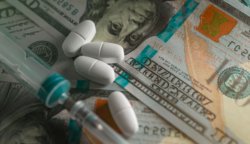October 15, 2020

GoFundMe Misery: Unaffordable Healthcare is Unavailable Healthcare
I spent some time this week scrolling through medical campaigns on the GoFundMe website. These campaigns seek funding to pay medical expenses for those with serious illness and injury. Their individual stories are remarkable. Their collective story is tragic.
Recipients of GoFundMe medical campaigns almost always pay commercial prices for healthcare services. In this way, GoFundMe medical campaigns have become another revenue source for America’s voracious healthcare delivery system. It has become routine at many hospitals to suggest that patients, families and/or friends launch GoFundMe campaigns to pay for expensive procedures, such as transplants.
Almost always, GoFundMe campaigns support individuals who have inadequate or no health insurance. The afflicted share intimate details of their illnesses and injuries in the hope that friends, acquaintances and strangers will come to their aid.
Many, perhaps most, Americans are one medical tragedy away from financial ruin. Even with discounts, vulnerable patients struggle to pay medical bills. So, it comes as no surprise that medical bills are the leading cause of personal bankruptcies.
A recent RAND Corporation analysis of nationwide healthcare prices found that hospitals charge private insurers 2.5 times more than Medicare for the same treatments.[1]
Despite arguments to the contrary, these markups are a form of profiteering. They make healthcare unaffordable.
Access and affordability go hand-in-hand. Unaffordable healthcare is unavailable healthcare. It places an enormous financial burden on working Americans, increases stress and compromises health status.
Healthcare needs and costs collide in GoFundMe medical campaigns. They provide a remarkable window into the American psyche as ordinary people confront extraordinary medical bills.
Digitizing Despair
According to their website, GoFundMe launches over 250,000 medical campaigns each year. They categorize medical conditions (cancer, surgery, etc.) to guide those wishing to launch and support campaigns. In aggregate, GoFundMe medical campaigns annually raise in excess of $650 million. This represents a third of total money raised from all GoFundMe campaigns.

As I write on October 13, 2020, the majority of the top ten fundraisers, including the top two, were for “medicine, illness and healing” and “accidents and emergencies.” Often friends organize, launch and sustain these campaigns. This was the case for October 13’s top “trending” medical campaign collecting funds for four young men seriously injured in a vehicle accident.
Leah Wainwright and Kayla McLain launched the campaign, titled “Recovery Road for Austin, Branden, Spencer & Ryan.” The four “boys” were driving from Wisconsin to Idaho for the “elk hunting trip of a lifetime.” Early morning on October 10th, events took an ironic and life-threatening turn. While driving through Montana, their minivan struck an elk, lost control and crashed.
All four young men are now in hospitals recovering from serious injuries, including broken vertebrae, fractured bones and head injuries. All face long roads to recovery and gigantic medical bills.
Wanting to relieve their friends’ financial stress, Leah and Kayla organized the GoFundMe campaign two days after the accident with a target funding goal of $85,000. They ended their plea with an emphatic “Let’s help crush their medical bills like a case of Busche [sic] Latte!”
So far, so good. Over 500 people have donated over $50,000. There are dozens of messages on the campaign site offering prayers and wishing for speedy recoveries.
Leah’s and Kayla’s campaign is among thousands of medical GoFundMe campaigns currently underway. Americans’ compassion and generosity in supporting these campaigns, often for individuals they don’t know personally, is awe-inspiring. Paraphrasing Abraham Lincoln, their selfless behavior reflects “the better angels of our nature.”
The GoFundMe experience is the opposite of that expressed in a quote often attributed to Joseph Stalin, “The death of one man is a tragedy. The death of a million is a statistic.” The need for hundreds of thousands of GoFundMe medical campaigns each year is a tragedy of unspeakable consequence. That tragedy has its roots in fragmented health insurance provision and excessively high prices for medical treatments.
Insane Prices
During the 1980s, it was impossible to live in the tri-state New York City region without being aware of Crazy Eddie’s high-voltage ads for televisions, stereos, camcorders and other electronic products. With a memorable tagline blasting into the airwaves, Crazy Eddie’s was never undersold because his prices were insane!
The way hospitals and doctors price healthcare treatments and tests is equally insane, but in the opposite direction. Providers rarely worry about being undersold. The vast majority of healthcare services is routine, yet there is enormous price variation. This occurs for numerous reasons relating to arcane pricing formularies, cross-subsidization, lack of transparency and negotiating leverage.

Cutting through the complexity, the underlying reason that providers charge excessive and varied prices for healthcare services is because they can. They exercise monopoly pricing power in many, perhaps most, of healthcare’s regional markets. Even large employers with thousands of employees cannot realize the benefits of competitive markets with transparent prices for healthcare services.
How significant is the price variation? A UnitedHealth Group report found that their commercial insurance clients experienced between 3-fold to more than 20-fold pricing disparities for seven routine diagnostic tests in 2017. Their clients overpaid for these tests by $18.5 billion.[2]
The Health Care Cost Institute (HCCI) tracks the cost of healthcare services nationally through their “Healthy Marketplace Index”[3] funded by the Robert Wood Johnson Foundation. In a 2019 study,[4] HCCI found that price variation for routine visits in 2016 “between” markets varied by as much as 25-fold.
- The median price for C-sections in San Francisco-Oakland-Hayward, CA ($20,721) was nearly 4.5 times that in Knoxville, TN ($4,556).
- A common blood test in Beaumont, TX ($443) costs nearly 25 times more than the same test in Toledo, OH ($18).
- Established patient office visits had median prices 3 times larger in Anchorage, AK ($165) than in Miami-Fort Lauderdale-West Palm Beach, FL ($60).
The HCCI study found even greater variation “within” markets, as high as a “39-fold price difference for the exact same service, even after removing the top and bottom 10% of prices to exclude outlier effects.” How is that possible? Some examples include the following.
- The median price of a vaginal delivery in Boston-Cambridge-Newton, MA-NH was $8,074, but actual prices ranged from $4,701 at the 10th percentile to $15,973 at the 90th percentile, a difference of $11,272.
- The price of a screening mammogram varied by more than 4-fold in Allentown-Bethlehem-Easton, PA, where the median price is $177.
- Some new patient office visits cost over 3 times more than other new patient office visits in Minneapolis-St. Paul-Bloomington, MN, where the median price was $229.
Overpricing and overtreatment are the fundamental flaws of the U.S. healthcare system. They lead to a monumental level of wasted spending, approaching $1 trillion annually.[5] Distribution, not funding, is American healthcare’s Achilles heel. Cut the waste, and there would be more than enough funding to provide great healthcare coverage for all Americans.
At the receiving end of the current system are ordinary Americans overpaying for health insurance that often isn’t sufficient to cover their costs during a medical crisis. They turn to GoFundMe campaigns out of desperation. They deserve better.
First Do No Harm
It is unrealistic to expect private philanthropy to overcome the systematic funding gap that exists between patients’ medical needs and their ability to pay sky-high medical bills. While there are numerous successful GoFundMe medical campaigns, 90% fail to reach their funding goal. On average, medical campaigns raise just 40% of their goal.[6]

During a 2019 interview with Kaiser Health News, GoFundMe CEO Rob Solomon said they didn’t expect to fund medical expenses when they launched the company in 2010, “We didn’t build the platform to focus on medical expenses… It saddens me that this is a reality. Every single day on GoFundMe, we see the huge challenges people face. Their stories are heartbreaking.”
Solomon emphasizes that he’d “love nothing more than for “medical” not to be a category on GoFundMe.” He notes that “we [at GoFundMe] feel good that our platform is there when people need it,” but also asserts that Americans die when they can’t pay for healthcare services they need.
Solomon saves his most stinging criticism for the U.S. health system itself.
The system is terrible. It needs to be rethought and retooled. Politicians are failing us. Health care companies are failing us. Those are realities. I don’t want to mince words here. We are facing a huge potential tragedy. We provide relief for a lot of people. But there are people who are not getting relief from us or from the institutions that are supposed to be there.
We shouldn’t be the solution to a complex set of systemic problems. They should be solved by the government working properly, and by health care companies working with their constituents. We firmly believe that access to comprehensive health care is a right and things have to be fixed at the local, state and federal levels of government to make this a reality.
— Rob Solomon, CEO GoFundMe
As Solomon makes clear, U.S. healthcare violates a principal rule of bioethics, “First, do no harm.” In its pursuit of revenues over outcomes, the U.S. healthcare system overtreats, undertreats, overcharges and neglects far too many patients who come under its care. Patients suffer physical, emotional and financial harm as a result.
Anyone with a heart wishes Leah and Kayla success in their “Recovery Road” medical campaign for their four friends. Anyone with a heart and a brain recognizes that they shouldn’t need to do this. It’s beyond time to fix America’s broken healthcare system. All Americans deserve access to appropriate and affordable healthcare.
Sources
- https://www.rand.org/pubs/research_reports/RR4394.html
- https://www.unitedhealthgroup.com/content/dam/UHG/PDF/2019/affordability-Diagnostic-Tests-Price-Variation.pdf
- https://healthcostinstitute.org/hcci-originals/healthy-marketplace-index/hmi
- https://healthcostinstitute.org/in-the-news/hmi-2019-service-prices
- https://jamanetwork.com/journals/jama/article-abstract/2752664
- https://www.washington.edu/news/2017/03/13/crowdfunding-for-medical-bills-a-band-aid-not-a-cure-all-uw-study-finds/





